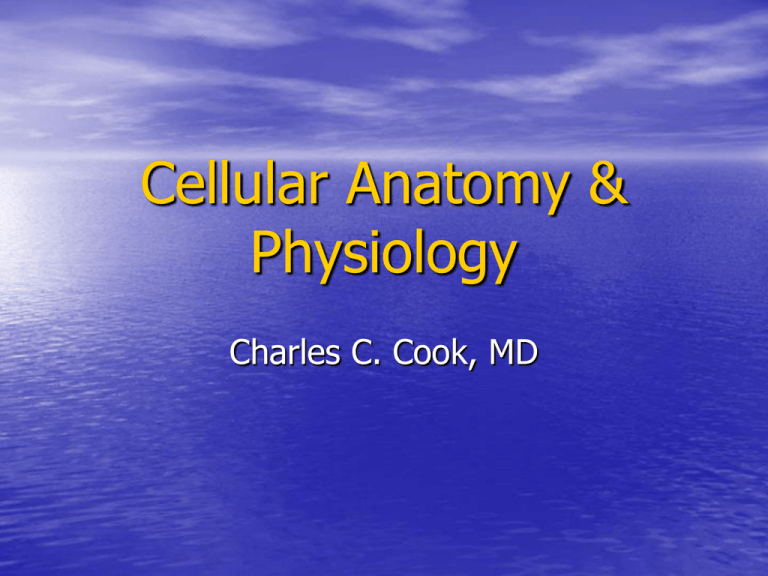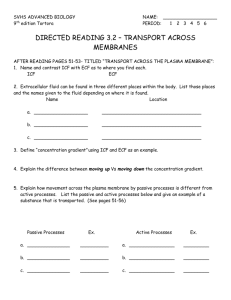Cellular Anatomy & Physiology
advertisement

Cellular Anatomy & Physiology Charles C. Cook, MD Membrane transport If only it was that easy! Osmosis • The flow of water across a semipermeable membrane from a solution of low solute to a solution of high solute Body Fluids & Their Compartments • Total body water—TBW – 60% of body weight • Distribution of TBW – Intracellular fluid (ICF) • Two-thirds of TBW • Major cations are K+ and Mg2+ • Major anions are protein and organic phosphates (ADP, ATP, AND AMP) Distribution of water (cont.) – Extracellular fluid (ECF) • One-third of TBW • Composed of interstitial fluid and plasma • Major cation is Na+ • Major anions are Cl- and HCO3– Plasma is one-fourth ECF Plasma proteins are albumin and globulins – Interstitial fluid is three-fourths of ECF Is an ultrafiltrate of plasma (has very little protein) Distribution of water (cont.) • 60-40-20 rule – TBW is 60% of body weight – ICF is 40% of body weight – ECF is 20% of body weight Compartments • To measure accurately one needs: – A substance that will stay in only one compartment – Substance is non-toxic – Substance has no direct effect on distribution of water – Substance mixes fairly quickly and evenly in the compartment – Substance is easily measured Measuring the Different Fluid Compartments • Dilution method – Place a known amount of substance that stays in one compartment – Examples • Tritiated water and D O for TBW • Mannitol, inulin, and sulfate for ECF • Evans blue and radioiodenated tagged serum albumin for 2 plasma • Interstitial =ECF vol-plasma vol • ICF= TBW-ECF vol Clinical Correlation • In infants and children their ECF/ICF ratio is larger but their absolute ECF is less than adults and this is why they tend to dehydrate faster and more severely than adults exposed to the same stressors. Movement Across the Cell Membrane • Simple diffusion • Carrier-mediated transport • Facilitated diffusion • Primary active transport • Secondary active transport Simple Diffusion • Not carrier mediated • Flows down an electrical gradient • Does not require energy Facilitated diffusion • Characteristics: – Moves “downhill” on an electrochemical gradient (similar to simple diffusion) – Does not require energy – Faster than simple diffusion – Carrier mediated* Facilitated diffusion (cont) • Examples: – Transport of glucose in muscle and fat cells • “downhill” • carrier-mediated • competitive (galactose) Carrier-mediated transport • Includes facilitated diffusion, primary and • secondary active transport Characteristics: – Stereospecificity—D-glucose and L-glucose – Saturation—transport increases until all carriers are saturated then become steady-state – Competition—structurally related solutes compete i.e. galactose and glucose in small bowel Clinical Correlation • In patients with diabetes mellitus, glucose uptake by the muscle and adipose cells is impaired because the carriers for facilitated diffusion of glucose require insulin. Knowing that serum glucose is elevated, applying what we know about solute movement, what can we see occurring in a patient? Primary active transport • Characteristics: – Occurs against an electrochemical gradient (“uphill”) – Requires energy in the form of ATP (hence the ‘active’) – Is carrier mediated* Primary active transport (cont) • Examples: – Na-K pump: located in the cell membrane and transports Na from intracellular to extracellular fluid and K in the opposite direction. Na and K are moved against their electrochemical gradient. ATP is used as energy source and the usual exchange is 3 Na/2 K. This is where the cardiac glycoside drugs oubain and digitalis work. Primary active transport (cont) • Examples (cont): – Ca pump: In the sarcoplasmic reticulum or cell membrane Ca is moved against an electrochemical gradient – Proton pump: Parietal cells in the stomach pump H+ into the lumen against a gradient. Omeprazole blocks this action. Secondary active transport • Characteristics: – Transport is coupled with two or more solutes. – One solute is transported “downhill” and provides the energy needed for the “uphill” transport. – Metabolic energy is provided indirectly from the Na gradient that is maintained across the cell membrane. Secondary active transport (cont) • Characteristics (cont) – If solutes move in same direction it is called cotransport or symport. – If solutes moved if opposite directions it is referred to as countertransport, exchange or antiport. Secondary active transport (cont) • Examples: – Na-glucose cotransport in the luminal membrane of intestinal mucosal and proximal tubule cells. – Na-Ca countertransport or exchange. Transports Ca “uphill” from low IC to high EC and Na moves in opposite direction “downhill”.** Membrane Potential • Definition – A membrane potential is the voltage across a cells’ membrane. This occurs because of the movements of charged particles across the membrane. (See, I told you that all that transport stuff really would be useful!) Resting Membrane Potential • This is simply the voltage across the membrane at rest. • This voltage is measured in millivolts (mV) • Ranges from -20 to -200 mV • These cells are polarized. • The cell membrane is more permeable to K than Na and the pump does not work in a 1:1 ratio. Resting Membrane Potential (cont) • This keeps the inside of the cell membrane negatively charged in relation to the outside. • Therefore K ions have the most influence on the resting membrane potential. Cell Organelles 1. 2. 3. 4. 5. 6. 7. Cell wall (plasma membrane) Mitochondria Lysosomes Peroxisomes Cytoskeleton Centromeres Cilia Cell Organelles (cont) 8. Cell adhesion molecules 9. Intercellular connections 10.Gap junctions 11.Endoplasmic reticulum 12.Ribosomes 13.Golgi apparatus 14.Nucleus The Cell Membrane Made up of: 1. Lipids 2. Proteins – Referred to as the plasma membrane – Double layer of lipids or bilayer with proteins – interspersed Lipid layer is primarily phospholipids but smaller amounts of cholesterol and glycolipids are present. Plasma membrane • The heads of lipid bilayer are hydrophilic and • • polarized. The tails (fatty acid chains) are hydrophobic and nonpolar. These are oriented toward the middle of the membrane. Proteins may extend all the way through the wall (integral proteins) while others are either inside or outside the membrane. Plasma membrane • Functions of the protein: – Cell adhesion – Pumps – Carriers – Ion channels – Receptors – Enzymes Functions of the plasma membrane Mitochondria • The powerhouse of the cell • Forms ATP through oxidative phosphorylation • The more active a tissue the more mitochondria • Has its own genome (always from the mother) • Mitochondrial DNA diseases Lysosomes • Function: – Consumes and digests worn-out cell components and external material such as bacteria that have been endocytosed. – Contain enzymes • More acidic than rest of the cytoplasm ( ph 5.0) • Arise from the Golgi apparatus Lysosomes • Lysosomal storage diseases – Fabry’s disease • Multi-organ function, pain – Gaucher’s disease • FTT, hepatosplenomegaly – Tay-Sachs disease • Ashkenazi Jews, MR, blindness Peroxisomes • Membranous sacs that contain powerful • • • enzymes esp. oxidases and catalases. Oxidases use molecular oxygen to detoxify harmful substances (ETOH & formaldehyde) Most important function of oxidases is to neutralize free radicals Peroxisomes are numerous in the liver and kidneys. Cytoskeleton • Fibers that give the cell its shape and ability to move. • Main fibers: – Microtubules – Microfilaments – Intermediate filaments Cytoskeleton (cont) • Microtubules – Largest of the three rods – Radiate out from the centrosome – Determine the overall shape of the cell – Mitochondria, lysosomes, and secretory granules attach to these and are moved by motor proteins Clinical Correlation of Microtubules • Microtubule assembly is prevented by colchicine and vinblastine. Taxol binds with them so that organelles cannot move. Due to the functions of these drugs, mitotic spindles can’t form and cells die. In this case cell death is good because it stops the formation of uric acid crystals and cancer cells (breast) Cytoskeleton (cont) • Intermediate filaments – Help the cell resist external pressure – Their absence causes cells to rupture easily Cytoskeleton (cont) • Microfilaments – Long strands of protein called actin which is the most abundant protein in mammals – Are associated with motion of some type • Myosin • Cell division • Amoeboid motion • Endocytosis • Exocytosis Centrosomes • Centrosomes act as a microtubule organizing center • Within the centrosome are 2 centrioles which form the basis of cilia and flagella Cilia








